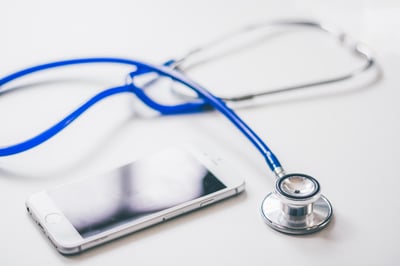
Healthcare apps for your smartphone can save money and eliminate the need to see a doctor face-to-face for routine illnesses and health-related questions. Mobile apps provide medical services and information giving patients needed advice. Use of these apps also provides patients with treatment recommendations when it is inconvenient to travel to the nearest doctor’s office.
Officially known as telehealth and telemedicine services, the use of these apps has the potential to fill healthcare gaps in rural communities.
According to a 2016 report from HIMSS Analytics, the use of telehealth and telemedicine services continued to grow at a rate of 3.5 percent per year.
What do Telehealth Services Include?
With apps such as Doctor on Demand or HealthTap, connecting to a doctor for a diagnosis of your symptoms, to schedule future tests, or to fill prescriptions is possible from your home. You can receive medical assistance for issues you’d normally seek treatment for from an urgent care facility. This includes conditions such as the flu, allergies, sinus infections, and migraines.

If you have an ongoing medical condition, such as diabetes, asthma, or high blood pressure, you can receive on-demand advice and recommendations. Other issues you can receive advice and counseling for include stress, anxiety and weight loss. You can also double check to see if it is okay to take certain medications at the same time.
Benefits for Patients and Rural Communities
Marc Shenker of Y Media Labs believes healthcare related smartphone apps will have several impacts on the interactions between patients and doctors. Patients will be able to save money by using apps that simulate a doctor’s visit and receive alerts when their health is starting to decline.
Another expected impact is the relationships between patients and doctors will become more supportive. Rural residents stand to benefit from telehealth services since their use leads to better quality care, reduced re-occurrences of health problems and reduced emergency room visits.
 Telehealth and telemedicine services have the potential to strongly impact local, rural economies. According to Becker’s Hospital Review, telemedicine resulted in an increase of $20,000 per year in economic activity for the states of Kansas, Oklahoma, Arkansas, and Texas. The overall impact on those local economies was $1.3 million, which came mostly from increases in lab and pharmacy revenues.
Telehealth and telemedicine services have the potential to strongly impact local, rural economies. According to Becker’s Hospital Review, telemedicine resulted in an increase of $20,000 per year in economic activity for the states of Kansas, Oklahoma, Arkansas, and Texas. The overall impact on those local economies was $1.3 million, which came mostly from increases in lab and pharmacy revenues.
Challenges in Rural Communities
The availability of broadband or high-speed internet service, Medicare/Medicaid reimbursement, and licensure for medical professionals are common obstacles rural communities must overcome to deliver telehealth services. Multiple grant programs exist to help combat these obstacles, including the USAC Rural Health Care Telecommunications Program and the Rural Broadband Access Loan and Loan Guarantee Program. The ability to attract and retain doctors in rural communities is a secondary challenge, despite high starting salaries.
Some major insurance plans cover the reimbursement costs of using telehealth services through designated smartphone apps.
Does your insurance plan offer this as an option? Have you ever used a smartphone app to get medical assistance or guidance? Tell us about your experiences!
